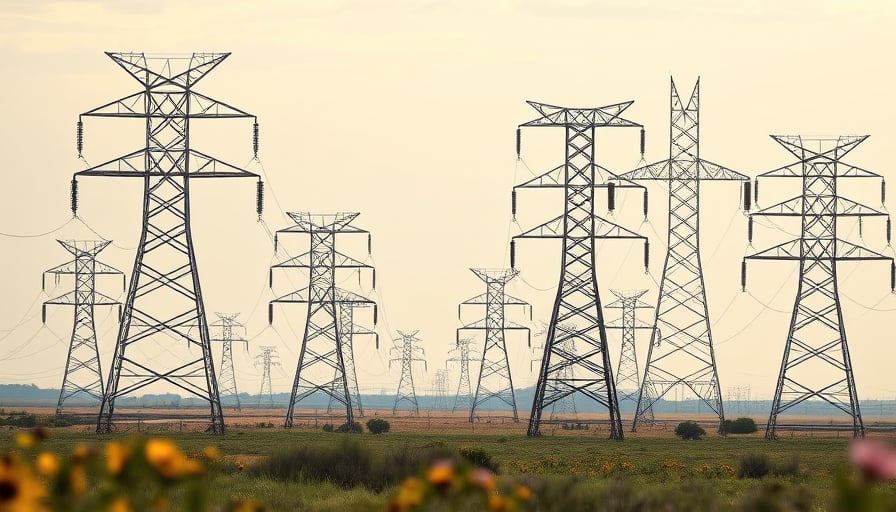Corporate News: Power Generation, Transmission, and Distribution Dynamics
Constellation Energy Corp. – Market Position and Infrastructure Outlook
Constellation Energy Corp., a Nasdaq‑listed utility that prioritizes carbon‑free power generation, experienced a decline in short interest of nearly twenty percent, reducing the proportion of shares sold short to just under two percent of the float. The company’s shares have traded near the upper end of their annual high, a reflection of broadly positive investor sentiment. Analysts highlight that Constellation’s infrastructure is becoming increasingly pivotal for the burgeoning data‑center market, exemplified by a recent power‑supply agreement that will support a new hyperscale facility in Texas. The firm’s overarching strategy continues to emphasize sustainable generation across nuclear, hydro, wind, and solar assets.
No additional material corporate events or earnings reports were disclosed for the period covered.
Technical Context: Grid Stability and Renewable Integration
1. Grid Stability in a High‑Renewable Era
Modern transmission and distribution networks must maintain synchronism and voltage stability while accommodating variable renewable energy sources (wind and solar). Constellation’s diverse mix of nuclear, hydro, wind, and solar assets provides a robust inertia profile: nuclear and hydro contribute mechanical inertia and controllable output, whereas wind and solar are inherently inertial‑less. To preserve system frequency, Constellation invests in inverter‑based synthetic inertia and fast‑response battery energy storage systems (BESS) at strategic substations. These technologies enable rapid active‑power adjustments in response to wind curtailment or solar intermittency, thereby mitigating frequency excursions.
2. Renewable Integration Challenges
- Curtailment and Curtailment Risk: The Texas hyperscale facility will draw significant, often fluctuating, demand. If wind output is temporarily high, grid operators may curtail production to prevent over‑generation. Constellation’s contract stipulates curtailment clauses to protect the data‑center’s reliability.
- Voltage Regulation: Wind farms can cause voltage rise when operating at high power factor. Constellation employs STATCOMs (Static Synchronous Compensators) and capacitor banks to manage reactive power, preserving voltage limits across the network.
- Contingency Management: The integration of large‑scale data‑center loads requires contingency analysis to ensure that the loss of any single transmission line or sub‑station does not compromise system security.
3. Infrastructure Investment Requirements
To support the projected growth in data‑center demand and renewable penetration, Constellation estimates an investment of $4–5 billion over the next decade in:
- High‑Voltage Transmission Upgrades: Expansion of 345 kV corridors to Texas and inter‑state corridors to facilitate power flow from hydro and nuclear baseload plants to the data‑center hub.
- Substation Enhancements: Installation of advanced protection relays and SCADA upgrades for real‑time monitoring of distributed generation resources.
- Distributed Energy Resources (DER) Integration: Development of microgrids and local battery storage near data‑center sites to absorb renewable variability.
- Grid Modernization Projects: Deployment of phasor measurement units (PMUs) and wide‑area monitoring for situational awareness and automated fault detection.
Regulatory and Economic Considerations
1. Regulatory Frameworks
- Transmission Planning: The Federal Energy Regulatory Commission (FERC) mandates that utilities demonstrate reliable transmission expansion plans under Order 745. Constellation’s Texas projects must align with the state’s deregulated market rules, ensuring compliance with the Public Utility Commission of Texas (PUCT) regulations on net‑metering and renewable integration.
- Rate Design: FERC’s “Cost‑of‑Service” regulation requires utilities to recover capital costs through rates. Constellation’s investment in grid upgrades will be reflected in the proposed rate schedule, subject to FERC and PUCT approval.
2. Rate Structures and Consumer Impact
- Energy‑Only vs. Capacity‑Based Rates: Constellation is exploring a hybrid rate model that captures both the marginal cost of energy and the value of capacity, especially during peak demand periods induced by data‑center workloads.
- Time‑of‑Use (TOU) Tariffs: To encourage load shifting, Constellation may introduce TOU tariffs that incentivize the data‑center to run high‑energy processes during off‑peak renewable generation periods, reducing reliance on peaking plants.
3. Economic Implications
- Capital Recovery vs. Consumer Costs: The proposed infrastructure spend translates into higher long‑term rates, but the benefit is a more resilient grid capable of absorbing renewable variability. The trade‑off is quantified through the Levelized Cost of Energy (LCOE) analysis, where the inclusion of BESS and enhanced transmission reduces LCOE for wind and solar by 3–5 % over a 20‑year horizon.
- Job Creation and Local Economy: Transmission upgrades and DER projects generate significant local employment opportunities, contributing to regional economic development, particularly in Texas.
- Strategic Value to Data Centers: Reliable, low‑carbon power supply is a differentiator for data‑center operators. Constellation’s capacity to provide continuous, renewable‑rich power can attract new data‑center investments, creating a virtuous cycle of grid utilization and revenue generation.
Conclusion
Constellation Energy Corp.’s strategic focus on a diversified, carbon‑free generation portfolio aligns with the technical demands of an evolving power system. The recent market metrics—declining short interest and a near‑peak share price—reflect investor confidence in the company’s long‑term resilience. The firm’s forthcoming investment in grid infrastructure, combined with sophisticated stability controls and a proactive regulatory stance, positions Constellation to meet the twin imperatives of renewable integration and data‑center reliability while managing economic impacts on consumers.
